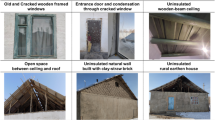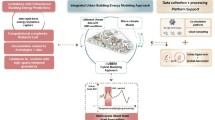Abstract
Natural ventilation is regarded as one of the most energy-efficient ways of ventilating a building. Suitable methods for predicting ventilation performance are essential for regulating indoor air parameters in buildings. This study establishes a method to predict the natural ventilation potential for residential buildings. The average annual ventilation rate (N) and annual cooling load saving ratio (ACSR) for the top six types of residential buildings were measured and analyzed under different conditions. The N calculation formula was summarized to calculate the natural ventilation air change rate for each of the designated buildings. In addition, the logarithmic regression curves of the ACSR (with N) were also obtained and then used to predict the natural ventilation potential for specific climatic conditions. The simulation results could be used to guide engineers in deciding when and where natural ventilation can be incorporated as an energy-efficient feature without affecting indoor comfort. Moreover, accurate strategic analysis could also be used to assist architects evaluate the potential of natural ventilation at the architectural pre-design stage.
Similar content being viewed by others
Abbreviations
- ACSR:
-
annual cooling load saving ratio of natural ventilation
- A o :
-
effective opening area for external envelopes (m2)
- A F :
-
total floor area of the ventilation rooms (m2)
- C 1 :
-
regression coefficient
- C 2 :
-
regression intercept
- C P :
-
wind pressure coefficient for the building surface
- C PAD :
-
coefficient for the effect of the PAD on natural ventilation potential
- C Q :
-
flow coefficient (m3/(s·Pan))
- D L :
-
distance of the center of the adjacent buildings in the direction of length (m)
- D w :
-
distance of the center of the adjacent buildings in the direction of width (m)
- G τ :
-
total air volume of ventilation of time τ (m3)
- H :
-
building height (m)
- H ref :
-
reference height from a nearby meteorological station (m)
- i :
-
total natural ventilation hours in a year
- L :
-
length of the local building (m)
- n :
-
flow exponent
- N :
-
annual average ventilation rate (h−1)
- N p :
-
approximate annual average ventilation rate (h−1)
- N ref :
-
reference value of annual average ventilation rate (h−1)
- PAD:
-
plan area density
- P S :
-
pressure difference between the pressure on the building surface and the local outdoor atmospheric pressure (Pa)
- q v :
-
volumetric flow rate through the opening (m3/s)
- Q 0 :
-
annual cooling load of a building without natural ventilation (kWh/m2)
- Q V :
-
annual cooling load of a building with natural ventilation (kWh/m2)
- R 2 :
-
determination coefficient
- ROF:
-
effective opening area ratio on external envelopes to the total floor of the ventilation rooms
- U H :
-
wind speed at the building height (m/s)
- U ref :
-
wind speed at the reference height (m/s)
- U(τ):
-
wind speed (m/s) of time element, dτ
- Ū :
-
average outdoor wind speed of ventilation hours in a year (m/s)
- V :
-
total volume of the natural ventilation rooms (m3)
- w :
-
width of the local building (m)
- ΔP :
-
pressure difference across the opening (Pa)
- α :
-
exponent for the local building terrain
- α ref :
-
exponent for the meteorological station
- δ :
-
wind boundary layer thickness for the local building (m)
- δ ref :
-
wind boundary layer thickness for the meteorological station (m)
- ρ 0 :
-
density of ambient air (kg/m3)
References
Allocca C, Chen Q, Glicksman L (2003). Design analysis of single-sided natural ventilation. Energy and Buildings, 35: 785–795.
Angel S, Parent J, Civco DL, Blei A, Potere D (2011). The dimensions of global urban expansion: Estimates and projections for all countries, 2000–2050. Progress in Planning, 75: 53–107.
ASHRAE (2013). ASHRAE Handbook of Fundamentals (SI), Chapter 16, Ventilation and Infiltration. Atlanta, USA: American Society of Heating, Refrigerating and Air-Conditioning Engineers.
Carrilho da Graça G, Chen Q, Glicksman LR, Norford LK (2002). Simulation of wind-driven ventilative cooling systems for an apartment building in Beijing and Shanghai. Energy and Buildings, 34: 1–11.
Chen Q (2009). Ventilation performance prediction for buildings: A method overview and recent applications. Building and Environment, 44: 848–858.
Chen Q, Glicksman L, Lin J, Scott A (2007). Sustainable urban housing in China. Journal of Harbin Institute of Technology (New Series), 14s: 6–9.
CIBSE (2005). CIBSE Application Manual 10: Natural Ventilation in Non-Domestic Buildings. London: Chartered Institution of Building Services Engineers.
Emmerich SJ, Dols WS, Axley JW (2001). Natural ventilation review and plan for design and analysis tools. National Institute of Standards and Technology (NISTIR), 2001(8), U.S. Department of Commerce.
Grosso M, Marino D, Parisi E (1995). A wind pressure distribution calculation program for multizone airflow models. In: Proceedings of 4th IBPSA International Conference, Madison, USA.
Humphreys MA (1975). Field studies of thermal comfort compared and applied. Journal of Installation Heating and Ventilation Engineer, 44: 5–27.
Krishan A, Baker N, Yannas S, Szokolay S (2001). Climate Responsive Architecture: A Design Handbook for Energy Efficient Buildings. New Delhi: Tata McGraw-Hill Education.
Ling H, Xie J, Yang W, Wang J, Zhu E, Jiang Q (2012). Statistical analysis of residential energy consumption measurement except heating in Beijing. Building Science, 28(S2): 271–275. (in Chinese)
National Meteorological Information Center of China, Tsinghua University (2005). Meteorological Data Set for Building Thermal Environment Analysis of China. Beijing: China Architecture & Building Press. (in Chinese)
National Standard of China, GB 50180-93 (2002). Code of Urban Residential Areas Planning & Design. Beijing: China Architecture & Building Press. (in Chinese)
National Standard of China, GB 50352-2005 (2005). Code for Design of Civil Buildings. Beijing: China Architecture & Building Press. (in Chinese)
National Standard of China, JGJ 26-2010 (2010). Design Standard for Energy Efficiency of Residential Buildings in Severe Cold and Cold Zones. Beijing: China Architecture & Building Press. (in Chinese)
Rowe D (1996). Mixed mode climate control: Some hands-on experience. AIRAH Journal, 50(12): 19–23.
Stavrakakis GM, Koukou MK, Vrachopoulos MGr, Markatos NC (2008). Natural cross-ventilation in buildings: Building-scale experiments, numerical simulation and thermal comfort evaluation. Energy and Buildings, 40: 1666–1681.
Tan G, Glicksman LR (2005). Application of integrating multi-zone model with CFD simulation to natural ventilation prediction. Energy and Buildings, 37: 1049–1057.
Wang L, Wong NH (2007). The impacts of ventilation strategies and facade on indoor thermal environment for naturally ventilated residential buildings in Singapore. Building and Environment, 42: 4006–4015.
Wang L, Wong NH (2008). Coupled simulations for naturally ventilated residential buildings. Automation in Construction, 17: 386–398.
Willmert T (2001). The return of natural ventilation. Architectural Record, 189(7): 137–146.
Xue F, Li X, Huang H (2013). Study on the influence on natural ventilation caused by diffent building densities. In: Proceedings of 13th IBPSA International Conference, Chambéry, France.
Yan D, Xia J, Tang W, Song F, Zhang X, Jiang Y (2008). DeST — An integrated building simulation toolkit Part I: Fundamentals. Building Simulation, 1: 95–110.
Yang L, Zhang G, Li Y, Chen Y (2005). Investigating potential of natural driving forces for ventilation in four major cities in China. Building and Environment, 40: 738–746.
Yao R, Li B, Steemers K, Short A (2009). Assessing the natural ventilation cooling potential of office buildings in different climate zones in China. Renewable Energy, 34: 2697–2705.
Yin W, Zhang G, Yang W, Wang X (2010). Natural ventilation potential model considering solution multiplicity, window opening percentage, air velocity and humidity in China. Building and Environment, 45: 338–344.
Zhai Z, Johnson MH, Krarti M (2011). Assessment of natural and hybrid ventilation models in whole-building energy simulations. Energy and Buildings, 43: 2251–2261.
Zhang M (2010). Analysis of the potential of building annual energy-saving using natural ventilation. In: Proceedings of 7th International Conference on Indoor Air Quality, Ventilation and Energy Conservation in Buildings (IAQVEC), Syracuse, USA.
Zhang R, Lam KP, Yao S, Zhang Y (2013). Coupled EnergyPlus and computational fluid dynamics simulation for natural ventilation. Building and Environment, 68:100–113.
Zhao L (2010). Research on the development of apartment of tower building. Beijing University of Civil Engineering and Architecture. (in Chinese)
Zhao R, Xia Y (1998). Effective non-isothermal and intermittent air movement on human thermal responses. In: Proceedings of 6th International Conference on Air Distribution in Rooms (ROOMVEN), Stockholm, Sweden, pp. 351–357.
Author information
Authors and Affiliations
Corresponding author
Rights and permissions
About this article
Cite this article
Li, Y., Li, X. Natural ventilation potential of high-rise residential buildings in northern China using coupling thermal and airflow simulations. Build. Simul. 8, 51–64 (2015). https://doi.org/10.1007/s12273-014-0188-1
Received:
Revised:
Accepted:
Published:
Issue Date:
DOI: https://doi.org/10.1007/s12273-014-0188-1




